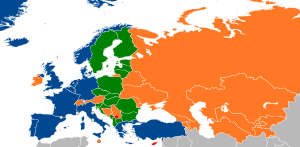Partnership for peace
The Partnership for Peace ( PfP) is a partnership established in 1994 for military cooperation between NATO and 20 European and Asian countries that are not NATO members.
The extent of cooperation can be determined by each participating country. Most of these are joint maneuvers and consideration of NATO standards when purchasing new military equipment. Participation in peacekeeping and peacebuilding missions of NATO is also possible via the PfP. There is also provision for NATO to be consulted if a signatory state is threatened from outside. However, the PfP is explicitly not a defense alliance; the duty of assistance remains reserved for NATO members.
Cooperation between NATO and the partner countries has been coordinated since 1997 in the Euro-Atlantic Partnership Council (EAPC), previously the North Atlantic Cooperation Council (NAKR).
From September 8th to 13th, 1996, for the first time in Germany at the Munster military training area , “Cooperative Lantern 96”, a staff framework exercise of the NATO program Partnership for Peace, with multinational participation from 18 countries.
Signatory States
The states that have signed the framework document include
- the former Soviet republics of Armenia , Azerbaijan , Georgia , Kazakhstan , Kyrgyzstan , Moldova , Russia , Tajikistan , Turkmenistan , Ukraine , Uzbekistan and Belarus ,
- the former Yugoslav republics of Bosnia and Herzegovina and Serbia ,
- the EU countries Finland , Ireland , Malta , Austria and Sweden ,
- the Switzerland .
Fourteen previous signatory states have since joined NATO : Albania , Bulgaria , Estonia , Croatia , Latvia , Lithuania , Montenegro , North Macedonia , Poland , Romania , Slovakia , Slovenia , the Czech Republic and Hungary .


